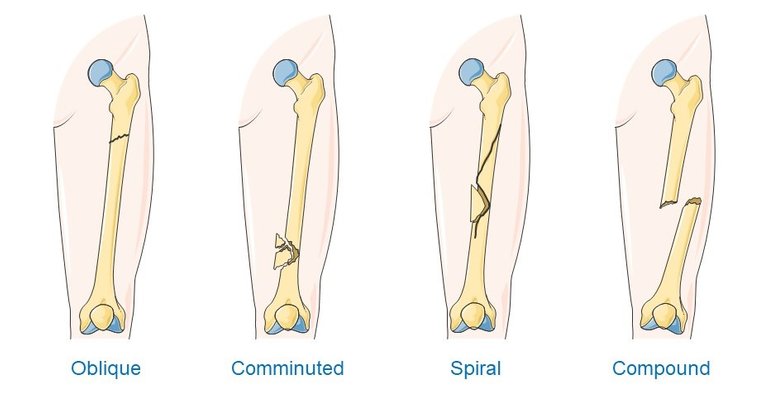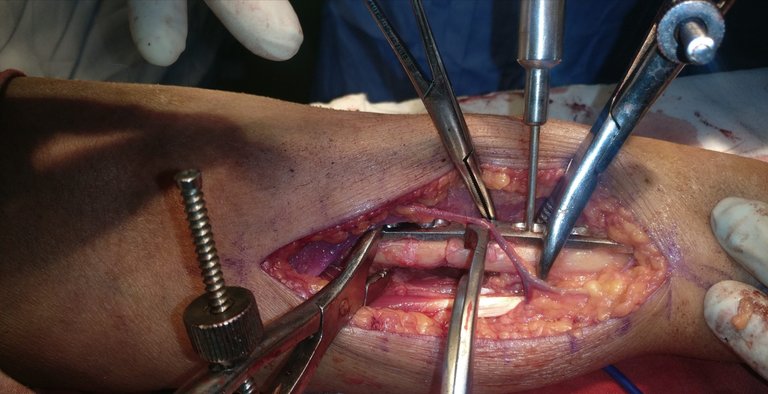Have you heard that broken bones heal faster in children than in adults? If you didn't know before then you can check out this write-up from Kids Health that discussed fractures in kids. Come to think of it, a fracture is just a more complex, or let me say a fancy word a broken bone. You see, when you are the doctor, it is easy to call it a fracture but when you are the patient, you know your bones are broken and do not even want to listen to the nomenclature given to the broken bones, you just want it to heal. Permit me to use fracture in this post for the sake of science.
Fractures can exist in different forms, meaning that your bones can be broken in different ways and they can be categorized. You see, scientists just thought of making a complex word for how diseases or conditions occur, and they called it pathophysiology, so we will go with that. When it comes to the pathophysiology of fracture, it can exist in different forms and they are; Closed Fracture where the bones are broken inside the skin, but do not break out of the skin. You remember that time when that friend of yours had a broken bone but his skin wasn't broken and he wasn't bleeding? That is a perfect example of a closed fracture. Then you may ask what about the fracture where your skin is broken? Well, that's an Open fracture. With Open Fracture (Compound Fracture) the skin is broken, and the bone protrudes through the skin. You know that broken bone that occured after an accident where the bone breaks the skin surface and you see blood vessels broken and blood gushing? Yes that is open fracture. That's said, there are other types of fractures, and they are Complete Fracture Where the bone is completely broken through into two or more places. This is a very rare one for me, as it happens as a result of a very fetal accident with with survivals. Another type of fracture is the incomplete fracture where the bone isn't broken completely, also known as GreenStick Fracture. One fracture that occurs in both children and adult is the spiral fracture which occurs due to rotational or twisting motions. In adult, it could be as a result of a fall, a blow or a sharp rotation, but in infants and children, it is basically as a result of child abuse. The fracture types are not finished, there is still the Oblique fracture and the Compression fracture which occurs as a result of impact such as from a high fall or a cliff. Have you seen witnessed an accident where an heavy object falls on a person and crushes the persons bone? that person just had a crush fracture.
You start to wonder why I am writing a post on fracture. Well, i saw a woman being arrested today because she beat her child and in the process broke the arm of the child. She said she did it because the child smached her phone to the ground. She said she acted out of anger but didn't intend to cause the child any harm. The child was less than 2 years old and didn't even know what was right or wrong. The baby could barely identify his left from his right hand. I didn't like the fact that the child was already experiencing a broken bone from the age of 2 years when he couldn't even defend himself. Well, similar to the child, most children experience fracture in their upper limb of the wrist, the forearm and above the elbow and Torus fracture is the most common type of fracture in children.
While accidents can cause a fracture, there are a few causes and risks that can cause fracture, and they include Osteoporosis (porous bones), corticosteroids/steroid such as Prednisone (Infact, it is common in drugs that have the -sone suffix with an example being corticosteroids), Trauma from an accident, and long term bone rest. When the fracture happens there are a few signs and symptoms which is noticed. These signs and symptoms include pain, edema (swelling), crepitus, bruising (in open fracture), muscle spasms. It can also cause hypotension, tachycardia, and hematuria as a result of internal bleeding. In cases where there is a basilar skull fracture, Cerebrospinal fluid are seen running down the nose, as situation known as Rhinorrhea. In cases of spinal fracture, patients could experience neurogenic shock, bradycardia, and hypotension. In cases where the fracture is located in the mandible (madibular fracture), there is bleeding and drooling in the mouth. In cases of hip fracture usually resulting from accident, patients experience shortening of the affected leg, Ecchymosis (bruises from broken capillaries), muscle spasm, Groin and hip pain. In cases where there is a fracture causing an uneven leg lenght, buck's traction can be used to put the bone in its place. Before you talk about Buck's traction, it is important to prioritize patients care as a health worker or medical practitioner. It is very important to stop the bleeding first if the patient is bleeding. Heamoglobin level lesser than seven is fatal for the patient, so it is important to deal with the bleeding. It is important to identify and monitor the pulse of the area distal to the injury, identify if the patient is suffering from hypotension or tachycardia (as this could be used to identify internal bleeding), then deal with any possible infection, as it is important to check for elevated White Blood Cell level, it is important to check the surgical site for changes in color, and odor to prevent infection. Treatment in most serious case of fracture such as hip and femur fracture is surgery. In the case of Hip and Femur surgery, procedures that can be done includes Total hip replacement just as its name implies, Open Reduction Internal Fixation (ORIF) where pins, plates, and screws are used to fix the fracture internally. In the case of Open reduction external fixation, the procedure is done externally. After a hip replacement, it is important to keep the toes abducted. Patients should not be allowed to cross legsm lean forward, or join legs together.
Finally, let me talk about complications with fractures. Patients with fracture can have complications such as fat embolism syndrome and it is common with the femur, and other long one fracture where fat globules are released into the bony area as a result of a fracture from a crush. It could lead to blockage in organs or in the central nervous system.
- https://www.hopkinsmedicine.org/health/conditions-and-diseases/fractures-in-children
- https://www.ncbi.nlm.nih.gov/pmc/articles/PMC4464690/
- https://www.hopkinsmedicine.org/health/conditions-and-diseases/fractures
- https://www.statpearls.com/ArticleLibrary/viewarticle/21947
- https://www.orthopaedicsurgeryspecialists.com/fractures-types-and-treatment.html
- https://www.ncbi.nlm.nih.gov/books/NBK551678/**

